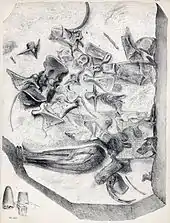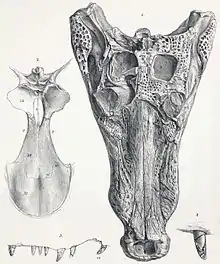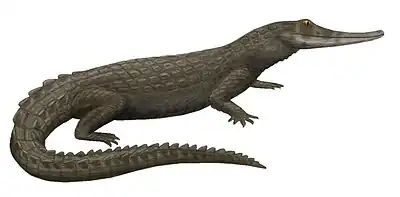Goniopholis
Goniopholis (meaning "angled scale") is an extinct genus of goniopholidid crocodyliform that lived in Europe during the Late Jurassic and Early Cretaceous.[1][2] Like other goniopholidids, it resembled living crocodilians, and probably had a similar ecology as semi-aquatic ambush predators.
| Goniopholis Temporal range: Late Jurassic - Early Cretaceous, | |
|---|---|
 | |
| Holotype skull of the "Swanage Crocodile", G. kiplingi on display at the Dorset County Museum. Berriasian age (earliest Cretaceous). | |
| Scientific classification | |
| Domain: | Eukaryota |
| Kingdom: | Animalia |
| Phylum: | Chordata |
| Class: | Reptilia |
| Clade: | Pseudosuchia |
| Clade: | Crocodylomorpha |
| Family: | †Goniopholididae |
| Genus: | †Goniopholis Owen, 1841 |
| Type species | |
| †Goniopholis crassidens Owen, 1841 | |
| Species | |
Discovery and species


The type species of the genus is G. crassidens which is known from the Berriasian of England, and the referable species G simus from the Berriasian of NW Germany, might be conspecific. Other species that are referable to Goniopholis include G. kiplingi from the Berriasian of England, and G. baryglyphaeus from the Late Jurassic (Kimmeridgian) of Portugal making it the oldest known Goniopholis species.[1][2] The species G. kiplingi honors the author Rudyard Kipling, "in recognition for his enthusiasm for natural sciences".[1] G. kiplingi had skull reaching 475.6 mm (18.72 in), it is one of the largest goniopholidid along with Amphicotylus milesi which had skull reaching 43 cm (17 in).[1][3] Based on skull length, total body length of G. kiplingi is estimated at 3.47 m (11.4 ft).[1]
Eggs attributed to Goniopholis were found in the Late Jurassic of Portugal.[4]
A partial skeleton of an indeterminate species of Goniopholis has been recovered from the Berriasian aged Angeac-Charente bonebed of France.[5]
Goniopholis have been inferred to have been ectothermic on the basis of bone histology and stable isotope analysis.[6]
Formerly assigned species
Two species were referred to Goniopholis from Brazil. Goniopholis hartti from the Lower Cretaceous of Brazil is in fact a member of the genus Sarcosuchus.[1] G. paulistanus, based on two tooth crowns and a disassociated fragment of the right tibia from the Upper Cretaceous Bauru Group, has been reassigned to Itasuchidae and given its own genus Roxochampsa.[7]
From North America, G. lucasii and G. kirtlandicus are currently placed in their own genera Amphicotylus and Denazinosuchus, respectively,[1] while G. felix, G. gilmorei, and G. stovalli, all from the Morrison Formation, are referable to Amphicotylus and closely related to Eutretauranosuchus which are known from the same formation.[8][9][10]
G. phuwiangensis is known from NE Thailand, but this species is fragmentary and was recently reassigned to Sunosuchus. Nannosuchus from the Early Cretaceous (Berriasian stage) of England and Spain currently considered to be valid, was referred to as G. gracilidens by some authors.[1]
Willett's / Hulke's, Hooley's and Dollo's goniopholidids represent several complete specimens previously classified as either G. simus or G. crassidens,[1] and one of them was recently re-described as the new species, G. willetti. More recently these specimens were removed from Goniopholis, and two of them, Hooley's and Hulke's goniopholidids, have been already reassigned to their own genera Anteophthalmosuchus and Hulkepholis, respectively.[2][11] Dollo's goniopholidid has also been assigned to Anteophthalmosuchus.[12]
Description
Like other goniophoilids, Goniopholis bears a superficial resemblance to modern crocodilians. However, unlike modern crocodilians and like other goniopholidids, the dermal armour covering the back was composed of two rows of large rectangular scutes running parallel down each side of the midline, with a "peg and groove" mechanism articulating the sets of plates together, with the outer edge of the plates deflected downwards.[1][13]
Ecology
Goniopholidids likely had a similar ecology to modern crocodilians as semi-aquatic ambush predators.[14]
Classification

.jpg.webp)
Below is a cladogram including several Goniopholis species:[1]
| Neosuchia |
| ||||||||||||||||||||||||||||||||||||||||||||||||||||||||||||||||||||||||||||||||||||||||||||||||||||||||||||||||||||||||||||||||||||
References
- De Andrade, M. B.; Edmonds, R.; Benton, M. J.; Schouten, R. (2011). "A new Berriasian species of Goniopholis (Mesoeucrocodylia, Neosuchia) from England, and a review of the genus". Zoological Journal of the Linnean Society. 163: S66–S108. doi:10.1111/j.1096-3642.2011.00709.x.
- Buscalioni, A.D.; Alcalá, L.; Espílez, E.; Mampel, L. (2013). "European Goniopholididae from the Early Albian Escucha Formation in Ariño (Teruel, Aragón, España)". Spanish Journal of Palaeontology. 28 (1): 103–122. doi:10.7203/sjp.28.1.17835.
- Yoshida, Junki; Hori, Atsushi; Kobayashi, Yoshitsugu; Ryan, Michael J.; Takakuwa, Yuji; Hasegawa, Yoshikazu (2021). "A new goniopholidid from the Upper Jurassic Morrison Formation, USA: novel insight into aquatic adaptation toward modern crocodylians". Royal Society Open Science. 8 (12): 210320. doi:10.1098/rsos.210320. ISSN 2054-5703. PMC 8652276. PMID 34909210.
- Russo, J., Mateus O., Marzola M., & Balbino A. (2017). Two new ootaxa from the late Jurassic: The oldest record of crocodylomorph eggs, from the Lourinhã Formation, Portugal. PLOS ONE. 12, 1-23.
- Ronan Allain, Romain Vullo, Lee Rozada, Jérémy Anquetin, Renaud Bourgeais, et al.. Vertebrate paleobiodiversity of the Early Cretaceous (Berriasian) Angeac-Charente Lagerstätte (southwestern France): implications for continental faunal turnover at the J/K boundary. Geodiversitas, Museum National d’Histoire Naturelle Paris, In press. ffhal-03264773f
- Faure-Brac, M.G.; Amiot, R.; de Muizon, C.; Cubo, J.; Lécuyer, C. (2021). "Combined paleohistological and isotopic inferences of thermometabolism in extinct Neosuchia, using Goniopholis and Dyrosaurus (Pseudosuchia: Crocodylomorpha) as case studies". Paleobiology. Cambridge University Press (for The Paleontological Society): 1–22. doi:10.1017/pab.2021.34.
- Piacentini Pinheiro, A.E.; da Costa Pereira, P.V.L.G.; de Souza, R.G.; Brum, A.S.; Lopes, R.T.; Machado, A.S.; Bergqvist, L.P.; Simbras, F.M. (2018). "Reassessment of the enigmatic crocodyliform "Goniopholis" paulistanus Roxo, 1936: Historical approach, systematic, and description by new materials". PLOS ONE. 13 (8): e0199984. Bibcode:2018PLoSO..1399984P. doi:10.1371/journal.pone.0199984. PMC 6070184. PMID 30067779.
- Allen, E. (2010). "Phylogenetic analysis of goniopholidid crocodyliforms of the Morrison Formation". Journal of Vertebrate Paleontology. 30 (Supp. 1): 52A. doi:10.1080/02724634.2010.10411819. S2CID 220429286.
- Pol, D.; Leardi, J.M.; Lecuona, A.; Krause, M. (2012). "Postcranial anatomy of Sebecus icaeorhinus (Crocodyliformes, Sebecidae) from the Eocene of Patagonia". Journal of Vertebrate Paleontology. 32 (2): 328. doi:10.1080/02724634.2012.646833. S2CID 86565764.
- Pritchard, A.C.; Turner, A.H.; Allen, E.R.; Norell, M.A. (2013). "Osteology of a North American Goniopholidid (Eutretauranosuchus delfsi) and Palate Evolution in Neosuchia". American Museum Novitates (3783): 1–56. doi:10.1206/3783.2. hdl:2246/6449. S2CID 73539708.
- Steven W. Salisbury; Darren Naish (2011). "Crocodilians". In Batten, D. J. (ed.). English Wealden Fossils. The Palaeontological Association (London). pp. 305–369.
- Martin, J.E.; Delfino, M.; Smith, T. (2016). "Osteology and affinities of Dollo's goniopholidid (Mesoeucrocodylia) from the Early Cretaceous of Bernissart, Belgium". Journal of Vertebrate Paleontology. 36 (6): e1222534. doi:10.1080/02724634.2016.1222534. hdl:2318/1635521. S2CID 89199731.
- Puértolas-Pascual, E; Mateus, O (2020-06-11). "A three-dimensional skeleton of Goniopholididae from the Late Jurassic of Portugal: implications for the Crocodylomorpha bracing system". Zoological Journal of the Linnean Society. 189 (2): 521–548. doi:10.1093/zoolinnean/zlz102. ISSN 0024-4082.
- Ristevski, Jorgo; Young, Mark T.; de Andrade, Marco Brandalise; Hastings, Alexander K. (April 2018). "A new species of Anteophthalmosuchus (Crocodylomorpha, Goniopholididae) from the Lower Cretaceous of the Isle of Wight, United Kingdom, and a review of the genus". Cretaceous Research. 84: 340–383. doi:10.1016/j.cretres.2017.11.008.
Sources
- Buffetaut, E; Ingavat, R (1983). "Goniopholis phuwiangensis nov. sp., a new mesosuchian crocodile from the Mesozoic of North-eastern Thailand". Geobios. 16 (1): 79–91. doi:10.1016/S0016-6995(83)80048-5.
- Holland, W. J. (1905). "A new crocodile from the Jurassic of Wyoming". Annals of the Carnegie Museum. 3 (3): 431–434. ISSN 0097-4463.
- Mook, C. C. (1964). "New species of Goniopholis from the Morrison of Oklahoma". Oklahoma Geology Notes. 24: 283–287. ISSN 0030-1736.
- Owen, R. 1878. Monograph on The Fossil Reptilia of the Wealden and Purbeck Formations, Supplement no. VII. Crocodilia (Goniopholis, Pterosuchus, and Suchosaurus). Palaeontological Society Monograph, p. 1-15.
- Owen, R. (1879). "On the Association of dwarf crocodiles (Nanosuchus and Theriosuchus pusilus, e. g.) with the diminutive mammals of the Purbeck Shales". Quarterly Journal of the Geological Society of London. 35 (1–4): 148–155. doi:10.1144/GSL.JGS.1879.035.01-04.02. S2CID 129650812.
- Salisbury, S. W.; Willis, P. M. A.; Peitz, S. & Sander, P. M. (December 1999). "The crocodilian Goniopholis simus from the Lower Cretaceous of north-western Germany". Special Papers in Palaeontology. 60: 121–148. ISBN 978-0-901702-67-8.
- Schwarz, Daniela (2002). "A new species of Goniopholis from the Upper Jurassic of Portugal". Palaeontology. 45 (1): 185–208. doi:10.1111/1475-4983.00233.


